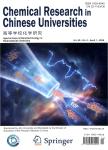Immobilization and Properties of Lipase from Candida rugosa on Electrospun Nanofibrous Membranes with Biomimetic Phospholipid Moities
Immobilization and Properties of Lipase from Candida rugosa on Electrospun Nanofibrous Membranes with Biomimetic Phospholipid Moities作者机构:Institute of Polymer Science Key Laboratory of Macromolecular Synthesis and Functionalization of Ministry of Education State Key Laboratory of Chemical Engineering Zhejiang University Hangzhou 310027 P. R. China
出 版 物:《Chemical Research in Chinese Universities》 (高等学校化学研究(英文版))
年 卷 期:2008年第24卷第2期
页 面:231-237页
核心收录:
学科分类:0710[理学-生物学] 071010[理学-生物化学与分子生物学] 081704[工学-应用化学] 07[理学] 08[工学] 0817[工学-化学工程与技术] 0703[理学-化学]
基 金:Supported by the National Natural Science Foundation of China for Distinguished Young Scholars(No50625309) the National Postdoctoral Science Foundation of China(No20060400337)
主 题:Biomimetic polymer Nanofibrous membrane Electrospinning Enzyme immobilization Lipase
摘 要:Reported here is a protocol to fabricate a biocatalyst with high enzyme loading and activity retention, from the conjugation of electrospun nanofibrous membrane having biomimetic phospholipid moiety and lipase. To improve the catalytic efficiency and activity of the immobilized enzyme, poly(acrylonitrile-co-2-methacryloyloxyethyl phosphorylcholine)s(PANCMPCs) were, respectively, electrospun into nanofibrous membranes with a mean diameter of 90 nm, as a support for enzyme immobilization. Lipase from Candida rugosa was immobilized on these nanofibrous membranes by adsorption. Properties of immobilized lipase on PANCMPC nanofibrous membranes were compared with those of the lipase immobilized on the polyacrylonitrile(PAN) nanofibrous and sheet membranes, respectively. Effective enzyme loading on the nanofibrous membranes was achieved up to 22.0 mg/g, which was over 10 times that on the sheet membrane. The activity retention of immobilized lipase increased from 56.4% to 76.8% with an increase in phospholipid moiety from 0 to 9.6%(molar fraction) in the nanofibrous membrane. Kinetic parameter Km was also determined for free and immobilized lipase. The Km value of the immobilized lipase on the nanofibrous membrane was obviously lower than that on the sheet membrane. The optimum pH was 7.7 for free lipase, but shifted to 8.3-8.5 for immobilized lipases. The optimum temperature was determined to be 35 ℃ for the free enzyme, but 42-44℃ for the immobilized ones, respectively. In addition, the thermal stability, reusability, and storage stability of the immobilized lipase were obviously improved compared to the free one.



